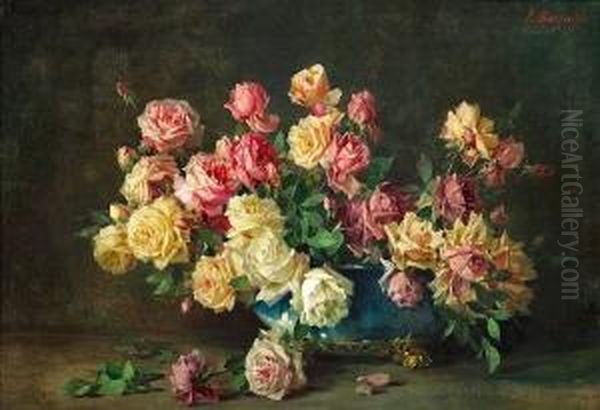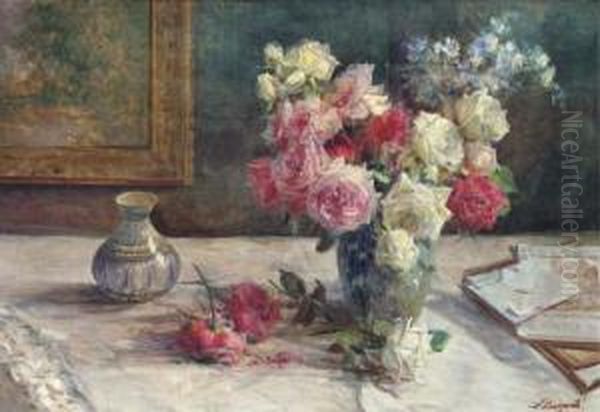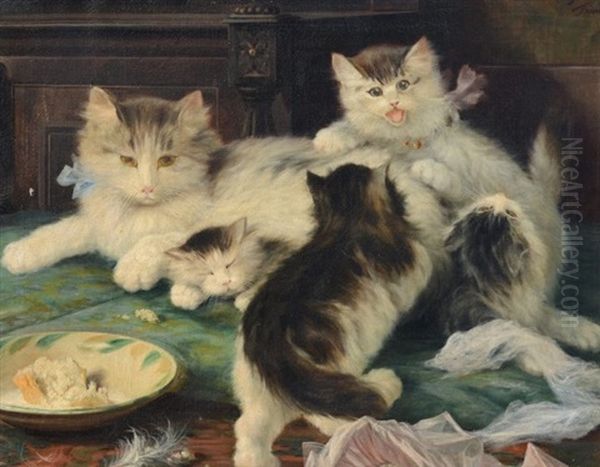Licinio Barzanti (1857–1944) was an Italian painter who carved a distinct niche for himself in the art world of the late 19th and early 20th centuries. While perhaps not as globally renowned as some of his more revolutionary contemporaries, Barzanti's dedication to the genres of still life and, to a lesser extent, landscape, coupled with his refined technique, earned him recognition and a lasting presence in art collections and auction houses. His work offers a charming window into the aesthetic sensibilities of his time, characterized by a delicate interplay of light, color, and an appreciation for the beauty of everyday objects and nature.
Biographical Sketch and Artistic Context
Born in Italy in 1857, Licinio Barzanti lived through a period of significant artistic transformation in Europe. This era saw the decline of strict academicism, the flourishing of Impressionism and Post-Impressionism, and the rise of various modern art movements. While detailed records of Barzanti's specific place of birth, death, or his formal artistic training and specific mentors are not extensively documented in readily available sources, it is clear he was an active participant in the Italian art scene. He passed away in 1944, having witnessed profound changes in both the art world and society at large.
The Italian art scene during Barzanti's active years was vibrant and diverse. While movements like the Macchiaioli had already made their mark by emphasizing painting from life with "spots" (macchie) of color, artists across Italy were exploring various stylistic paths. Some, like Giovanni Boldini (1842-1931) and Giuseppe De Nittis (1846-1884), achieved international fame with their elegant portraits and cityscapes, often embracing a style that blended academic skill with Impressionistic vivacity. Others, such as Silvestro Lega (1826-1895), a prominent figure of the Macchiaioli, focused on intimate scenes of domestic life, rendered with a profound sensitivity.
The Art of Licinio Barzanti: Style and Subjects

Licinio Barzanti is primarily celebrated for his exquisite still life paintings, particularly those featuring flowers. His canvases often burst with roses, pansies, and other blooms, meticulously arranged in vases or casually strewn, capturing their delicate textures and vibrant hues. Works such as Still life of roses and pansies and Roses in a Vase exemplify his mastery in this domain. He possessed a keen eye for detail and a remarkable ability to render the play of light on petals and leaves, imbuing his subjects with a lifelike freshness.
His artistic style shows an affinity with the principles of Impressionism, particularly in his handling of light and color, reminiscent of artists like Pierre-Auguste Renoir (1841-1919), whose influence is noted by some critics. Barzanti employed soft, harmonious color palettes and delicate brushwork, creating compositions that are both visually appealing and emotionally resonant. He sought to capture the "joy and freshness of everyday life," a quality that shines through in his floral arrangements and other still life subjects, such as Books on a Table . This focus on the beauty of the mundane, while perhaps considered a "lower" genre by some academic purists of earlier centuries, found a receptive audience and allowed Barzanti to explore subtleties of form and light.
Beyond floral still lifes, Barzanti also painted landscapes, such as Mountain Flowers , demonstrating his versatility and his appreciation for the natural world. Another charming example of his thematic range is Mother Cat and Kittens at Play, a work that showcases his ability to capture tender, animated scenes. It is noted that he consciously avoided mere repetition of themes, striving for originality within his chosen genres. Many of his works bear his signature and sometimes the year of creation, aiding in their authentication and study.
Notable Works and Market Presence
Several of Licinio Barzanti's paintings have appeared in public auctions, attesting to a continued appreciation for his work among collectors.
Still life of roses and pansies: A quintessential example of his floral work, showcasing his delicate touch and understanding of color.
Roses in a Vase: This title, or variations thereof, represents a recurring and popular theme in his oeuvre, highlighting his specialization.
Books on a Table: Demonstrates his skill in rendering different textures and objects, moving beyond purely floral subjects.
Mother Cat and Kittens at Play: An oil painting (20 x 22 inches) that was estimated at a significant value, indicating the appeal of his genre scenes.
Mountain Flowers: Illustrates his engagement with landscape painting, likely imbued with the same sensitivity to light and color found in his still lifes.

A still life measuring 46 x 28 cm by Barzanti was also noted with a high auction estimate, further underscoring the market value his works can achieve.
The consistent appearance of his paintings in sale catalogues, often with respectable valuations, indicates that Barzanti, while perhaps not a household name on the scale of some contemporaries, maintained a solid reputation and his art continues to be sought after.
Contemporaries and the Italian Artistic Milieu
Licinio Barzanti operated within a rich artistic landscape. In Italy, the late 19th and early 20th centuries were a period of diverse artistic expression. The legacy of the Macchiaioli, including artists like Giovanni Fattori (1825-1908) and Telemaco Signorini (1835-1901), continued to influence Italian painting with their commitment to realism and capturing the effects of light outdoors. Their focus on everyday Italian life and landscape provided a counterpoint to more academic traditions.
Other notable Italian artists of his general era include Antonio Mancini (1852-1930), known for his impasto technique and psychologically insightful portraits, and Francesco Paolo Michetti (1851-1929), who depicted scenes of Abruzzese peasant life with vibrant realism. The Symbolist and Divisionist movements also gained traction in Italy, with figures like Gaetano Previati (1852-1920) exploring more spiritual and allegorical themes through innovative color theories. Even sculptors like Medardo Rosso (1858-1928) were pushing boundaries, capturing fleeting impressions in wax and bronze, paralleling some of the concerns of Impressionist painters.
It's interesting to note the name Luigi Barzanti (1857-1946), an artist whose lifespan almost exactly mirrors Licinio's. While sharing a surname and period, the specific nature of their relationship, if any, is not immediately clear from the provided information. Another artist named Bernardino Licinio (c. 1489 – c. 1565) was a Venetian painter of the Renaissance, active much earlier, but the shared "Licinio" in their names is a point of passing interest, though there is no direct artistic lineage. The names Raff. Gladioli (active c. 1826-1900) and an artist initialed as MIS. (active c. 1826-1900) are also mentioned as contemporaries, though further details about their specific contributions would require more in-depth research. The painter Vittorio Matteo Corcos (1859-1933) was another contemporary, known for his elegant portraits of women and genre scenes that captured the Belle Époque spirit.

While Barzanti's style was more intimately focused than the grand history paintings or the avant-garde manifestos of some of his peers, his dedication to still life placed him within a long and respected tradition, which he approached with a modern sensibility influenced by the era's fascination with light and personal expression.
Legacy and Art Historical Significance
In assessing Licinio Barzanti's position in art history, it's important to recognize him as a skilled and dedicated painter who excelled within his chosen specializations. He may not have been a radical innovator who dramatically altered the course of art history in the way that figures like Titian or Pordenone (Giovanni Antonio de Sacchis) did in their respective eras, or as the leading Impressionists did in his own. However, his contribution lies in the consistent quality and charm of his work, particularly his floral still lifes.
His paintings demonstrate a high level of technical proficiency, a sophisticated understanding of color and light, and an ability to imbue his subjects with a sense of vitality and grace. The influence of Impressionism, particularly Renoir, is evident in the softness of his forms and the luminosity of his canvases, suggesting an artist who was aware of and responsive to contemporary artistic developments.
While the genre of still life was sometimes viewed within the academic hierarchy as less prestigious than historical or religious painting, artists like Barzanti demonstrated its potential for profound artistic expression and popular appeal. His works continue to be appreciated for their beauty, their technical skill, and the gentle joy they convey. His success in the art market, both during his lifetime and posthumously, speaks to a sustained admiration for his particular vision. He remains a notable figure among Italian painters of his generation who focused on the intimate beauty of the everyday.
Conclusion
Licinio Barzanti (1857–1944) stands as a testament to the enduring appeal of skillfully rendered still life and landscape painting. An Italian artist who navigated the rich artistic currents of the late 19th and early 20th centuries, he developed a distinctive style characterized by delicate brushwork, a keen sensitivity to light and color, and an ability to capture the inherent beauty of his subjects, particularly flowers. While not a revolutionary figure, his works, such as Still life of roses and pansies, Roses in a Vase, and Mother Cat and Kittens at Play, continue to charm collectors and art enthusiasts. His art provides a delightful glimpse into a world where the quiet observation of nature and everyday objects could be transformed into canvases of lasting beauty and appeal, securing his place as a respected painter of his time.